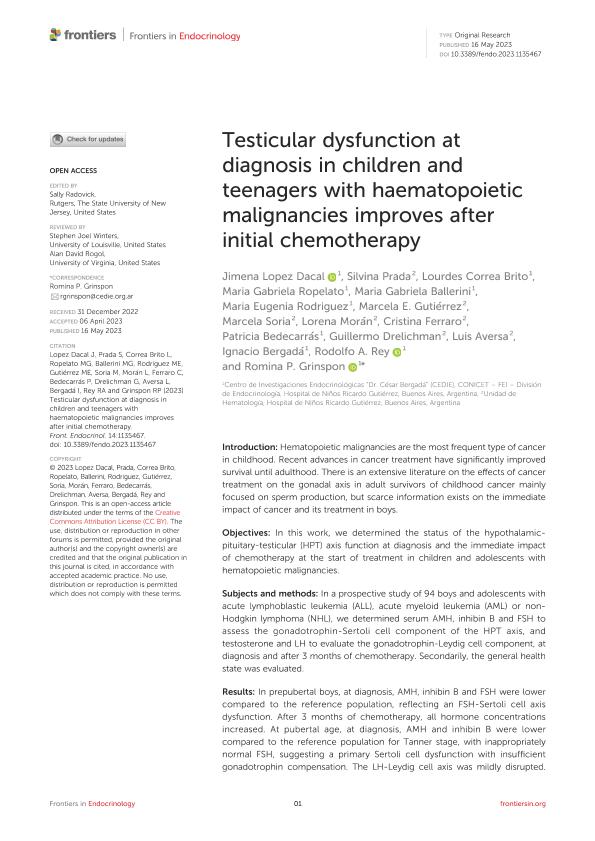Artículo
Testicular dysfunction at diagnosis in children and teenagers with haematopoietic malignancies improves after initial chemotherapy
Lopez Dacal, Jimena Claudia; Prada, Silvina; Correa Brito, Lourdes Magdalena ; Ropelato, Maria Gabriela
; Ropelato, Maria Gabriela ; Ballerini, Maria Gabriela; Rodriguez, Maria Eugenia; Gutiérrez, Marcela E.; Soria, Marcela; Morán, Lorena; Ferraro, Cristina; Bedecarrás, Patricia; Drelichman, Guillermo; Aversa, Luis; Bergadá, Ignacio
; Ballerini, Maria Gabriela; Rodriguez, Maria Eugenia; Gutiérrez, Marcela E.; Soria, Marcela; Morán, Lorena; Ferraro, Cristina; Bedecarrás, Patricia; Drelichman, Guillermo; Aversa, Luis; Bergadá, Ignacio ; Rey, Rodolfo Alberto
; Rey, Rodolfo Alberto ; Grinspon, Romina
; Grinspon, Romina
 ; Ropelato, Maria Gabriela
; Ropelato, Maria Gabriela ; Ballerini, Maria Gabriela; Rodriguez, Maria Eugenia; Gutiérrez, Marcela E.; Soria, Marcela; Morán, Lorena; Ferraro, Cristina; Bedecarrás, Patricia; Drelichman, Guillermo; Aversa, Luis; Bergadá, Ignacio
; Ballerini, Maria Gabriela; Rodriguez, Maria Eugenia; Gutiérrez, Marcela E.; Soria, Marcela; Morán, Lorena; Ferraro, Cristina; Bedecarrás, Patricia; Drelichman, Guillermo; Aversa, Luis; Bergadá, Ignacio ; Rey, Rodolfo Alberto
; Rey, Rodolfo Alberto ; Grinspon, Romina
; Grinspon, Romina
Fecha de publicación:
05/2023
Editorial:
Frontiers Media
Revista:
Frontiers in Endocrinology
e-ISSN:
1664-2392
Idioma:
Inglés
Tipo de recurso:
Artículo publicado
Clasificación temática:
Resumen
Introduction: Hematopoietic malignancies are the most frequent type of cancer in childhood. Recent advances in cancer treatment have significantly improved survival until adulthood. There is an extensive literature on the effects of cancer treatment on the gonadal axis in adult survivors of childhood cancer mainly focused on sperm production, but scarce information exists on the immediate impact of cancer and its treatment in boys. Objectives: In this work, we determined the status of the hypothalamic-pituitary-testicular (HPT) axis function at diagnosis and the immediate impact of chemotherapy at the start of treatment in children and adolescents with hematopoietic malignancies. Subjects and methods: In a prospective study of 94 boys and adolescents with acute lymphoblastic leukemia (ALL), acute myeloid leukemia (AML) or non-Hodgkin lymphoma (NHL), we determined serum AMH, inhibin B and FSH to assess the gonadotrophin-Sertoli cell component of the HPT axis, and testosterone and LH to evaluate the gonadotrophin-Leydig cell component, at diagnosis and after 3 months of chemotherapy. Secondarily, the general health state was evaluated. Results: In prepubertal boys, at diagnosis, AMH, inhibin B and FSH were lower compared to the reference population, reflecting an FSH-Sertoli cell axis dysfunction. After 3 months of chemotherapy, all hormone concentrations increased. At pubertal age, at diagnosis, AMH and inhibin B were lower compared to the reference population for Tanner stage, with inappropriately normal FSH, suggesting a primary Sertoli cell dysfunction with insufficient gonadotrophin compensation. The LH-Leydig cell axis was mildly disrupted. After 3 months of chemotherapy, inhibin B and AMH were unchanged while median FSH levels rose to values that exceeded the reference range, indicating a significant impairment of Sertoli cell function. Testosterone normalized concomitantly with an abnormal LH elevation reflecting a compensated Leydig cell impairment. General health biomarkers were impaired at diagnosis and improved after 3 months. Conclusion: The HPT axis function is impaired in boys with hematopoietic malignancies before the initiation of chemotherapy. There is a primary testicular dysfunction and a concomitant functional central hypogonadism that could be due to an impaired overall health. The HPT axis function improves during the initial 3 months of chemotherapy concomitantly with the general health state. However, in pubertal boys the dysfunction persists as shown by elevated gonadotropin levels after 3 months.
Palabras clave:
AMH
,
CHEMOTHERAPY
,
GONADOTROPINS
,
HYPOGONADISM
,
INHIBIN B
,
LEUKEMIA
,
LYMPHOMA
,
TESTOSTERONE
Archivos asociados
Licencia
Identificadores
Colecciones
Articulos(CEDIE)
Articulos de CENTRO DE INVESTIGACIONES ENDOCRINOLOGICAS "DR. CESAR BERGADA"
Articulos de CENTRO DE INVESTIGACIONES ENDOCRINOLOGICAS "DR. CESAR BERGADA"
Citación
Lopez Dacal, Jimena Claudia; Prada, Silvina; Correa Brito, Lourdes Magdalena; Ropelato, Maria Gabriela; Ballerini, Maria Gabriela; et al.; Testicular dysfunction at diagnosis in children and teenagers with haematopoietic malignancies improves after initial chemotherapy; Frontiers Media; Frontiers in Endocrinology; 14; 1135467; 5-2023; 1-10
Compartir
Altmétricas



